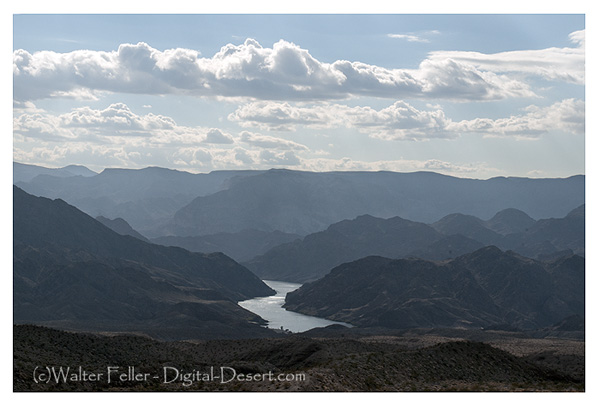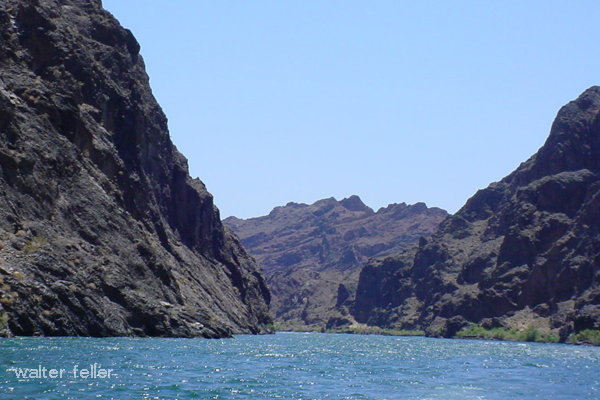South to the Mohave Villages

The horses were driven in and crossed over after crossing all over and moved down the river a mile and camped. When we crossed the river, an Indian and his family were living. They had pumpkin, squash, and beans growing on a small spot of alluvial soil on the river bank. I purchased the different kinds, and he showed me where he had wheat sown or planted 20 or 30 grains in the hills. The river entered a low but rugged mountain; I found it necessary to turn off from it to the left. My guides informed me that it was more than a day's travel to the next accessible point on the river where water was available. I determined to wait until the day's heat was over and travel as much as possible at night. At the proper time, we moved on a southeast course up a wide gravelly ravine nearly parallel with the obstructing range of mountains. At 11 or midnight, we unpacked and hobbled our horses and slept until the first appearance of light when we prepared and moved on for three hours in the direction of yesterday. The mountains then became lower; we turned through a low pass S S W. After traveling 2 hours more over terrible rocks, we arrived at the river where, although we found water which we very much needed, there was nothing for the hungry and weary horses to eat. The Indians had carried water in the bladder of an antelope which they divided with us, yet it was nothing among so many. Just below camp, the river again enters the rocks.

The following day we started early, leaving the river and traveling S E 4 or 5 miles up a ravine. We got where the hills are fewer and more detached. I have so often described the country of that same barren and rough kind. My guides had left me in the morning, but I had been able to follow their tracks in the sand. The trail turned toward the river through a range of rough hills by a narrow and deep ravine obstructed by rocks. I was apprehensive I would not be able to pass with my horses. As I was far ahead of the party and on foot, I pushed on to see the worst. I found some challenging places but seeing no other chance to proceed after taking a drink from the river, I returned to meet the company. They had been clambering and winding among the rocks and were now about three miles from the river. Being now night and a place before us that would require some hours to pass, I unpacked the horses and left them as they could not return because of the steep places we had come down.

One of the men had become so lame that he could not walk and was obliged to remain while the party moved on to the river on foot. As soon as light the next day, we returned and, with cords, lowered our goods down the precipice where a mistake would have been in its consequences of inevitable destruction.* (* It was at this place a party from Taos saw my trail.) But fortunately, we passed safely and, packing up, pushed onto the river where there was a little grass for our horses. The next day I moved 10 miles down the river, the hills not as bad as they had been. During the day, some Indians met us having some dried pumpkins. Finding tolerable grass, I remained for two days. I killed a mountain sheep, and we caught some pretty good fish with the hook and line. One of my men found a singular substance, some fine pieces of stone about twice as large as a large pea firmly fixed in the side of a flat rock. The appearance of an abundance of iron ore is here. Most certainly, if a country produces minerals in proportion to its barrenness, it must be rich in mineral production.
I had lost many horses, and some remaining could not carry anything. I got the Indians to assist me in moving down to where there were several lodges. These Indians are a different nation from the Paiute. They called themselves A-muc-ha-ba's [Mojave] and appeared quite friendly, bringing me corn beans, dried pumpkins, etc., which I paid them for in beads, rings, vermilion, etc. At this place, there is considerable timber on the river, and the soil might permit the making of small farms. There were but 3 or 4 horses among them, but I did not succeed in purchasing them. Very little beaver sign on the river. By inquiry, I found that the principal part of this tribe was 30 or 40 miles down the river. I remained there for two days when several Indians came from the village below. Among these were one or two that could speak Spanish, and as I had a man who could speak Spanish, I could converse with them. I then moved on down the river accompanied by the Indians who had come up from the settlements below. The distance was upwards of thirty miles, and the country was barren.